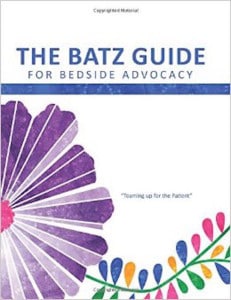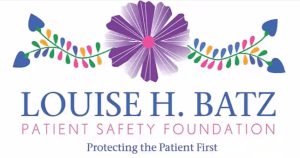
Some of you might know that I'm on the board of a Texas-based non profit, the Louise H. Batz Patient Safety Foundation. It's an important organization that helps patients, family members, and hospitals work together in the name of better care and safer care.
One of the ways the Foundation helps is their publication “The Batz Guide for Bedside Advocacy.” You can get a free PDF version or get a free iPad app version that does even more than a book can. Or, another option is to buy a paperback version via Amazon, which basically just covers costs and shipping.
The Foundation gives away a lot of Guides, but I think that the ROI of a hospital or employer purchasing Guides would be overwhelmingly positive (in addition to the core human benefits of protecting people and saving lives). More on that later in the post.
A friend of mine had surgery last year and knew she was going to be hospitalized for a few days. I gave her a copy of the Guide and asked her to use it. We're always trying to find the fine line between increasing awareness about the risks we face in hospitals without overly alarming people.
After her stay, my friend said the Guide was incredibly helpful for tracking who was doing what and what was supposed to be happening. Her comment was, “It was scary how much the hospital expected me to manage my care when I was on narcotics!” It probably shouldn't be that way… but that's the current reality and that's why The Batz Guide is so useful.
Why was the Guide created? This video shows Laura Townsend talking about the death of her mother, Louise Batz, as the result of a preventable medical error in the hospital after surgery (medication errors / overdose):
The Guide was created and vetted by doctors and medical professionals. It seems that the best “implementations” (or “adoptions”) of the Guide have been in partnership with hospitals and health systems. So far, that includes hospitals in the Austin and San Antonio areas and the Batz Foundation has a recent agreement with the UPMC system in Pittsburgh to use the Guide.
You might ask, “But this is just a book — what's to implement?”
Ways of Distributing the Guide
Let's talk through the different ways this book could be used.
First is the patient-driven model. An individual patient gets their own copy the Guide (as in the case of my friend), you're then at a pre-surgical appointment or admitted to the hospital and you're writing all sorts of things down. This might concern nurses, doctors, and administrators who might, sadly, think they have a litigious patient on their hands. If the caregivers and managers don't know about the Guide and the intent (protecting patients and avoiding things like medication mistakes), you might not get a lot of cooperation.
The second model is a loose partnership with a hospital where they make the Guide available to patients in some informal way. This might include having copies of the Guide available at the hospital or they provide a link to the iPad app. In this model, the hospital has officially endorsed or blessed the use of the Guide and has hopefully educated nurses, physicians, and others about the Guide, how it's used, how to partner with the patients, and the goals.
It's easy to measure how many hospitals are helping distribute the Guide, easy to measure how many apps are downloaded, and easy to measure how many books are in people's hands. It's a necessary step to get the Guides in people's hands…
But, I think we're all interested in measuring meaningful outcomes. What's the benefit and what are the results that come from using the Guide?
Measuring Improvement Outcomes
The Batz Foundation folks are in agreement that a better model, a third model, for distributing guides includes a more programatic approach to how Guides are made available. And this includes measuring results.
A more formal partnership with a hospital might include determining the best way to integrate the Guide into a patient journey. Instead of just passively making Guides available in the hospital, some hospitals purposefully introduce the Guide during a pre-surgical appointment. Having some scripting about the Guide would be more helpful than just handing it to somebody in a pile of papers.
I think there would better commitment and engagement from those on the hospital side if they had RESULTS and MEASURES that demonstrate how the Guide is helpful. We wouldn't want people just giving the Guide out “because management told us to.”
Listen to Mark read this post (and subscribe to the series):
But, getting those measures is difficult. The Foundation has anecdotal stories, including my friend's, about how the Guide helped prevent an error. But, how can we measure those results?
If a hospital has good baseline data, and then distributes the Guide to all of their surgical patients or all of their inpatients, we'd hope to see a reduction in errors and different types of harm. But, the results are confounded with all of the other things the hospital should be doing to improve quality and safety. It would be hard to prove “how much” of the improvement comes from using the Guide, but that would be great to try to measure.
One hospital that uses the Guide has reported that they think the average length of stay for patients using the Guide has been 0.5 days lower. That has a great impact on quality (reducing opportunities for error), patient flow, and the bottom line for hospitals (or the payers, depending on the reimbursement model).
Hospital Trials
Would your hospital be interested in partnering up with The Batz Foundation to use these Guides in a structured, programmatic way — including trying to measure and report results? Please contact the Foundation if you're willing to do so or if you can help make introductions at a level of leadership that can make this happen.
The Foundation has posters, training materials, brochures and other material that can be used to make this a systematic adoption and implementation. Guides can be made available for free, but what we'd ask in return is for your hospital to work on a systematic adoption process and to work to measure and share results (which could be blinded / anonymized).
Employer / Payer Trials
While I am self-employed, I have health coverage through my wife's job and the big company that employs her. Companies that provide coverage are concerned about reducing costs and improving outcomes. There's a human interest and a financial interest.
My idea has been to try to find an employer who would be willing to provide Batz Guides to their employees and covered dependents. They should probably do more than just make books available, going further to partner with hospitals and health systems that are major providers of care for them.
My hypothesis is that an employer, especially one who is “self insured,” could measure the results on cost and quality — comparing patients who had been given the Guide (and were in hospitals that embraced this approach) with patients who did not have the Guide.
If you're an employer (or insurer) who would like to go through a formal implementation of the Guide with patients and providers, please contact us.
Results Matter
I think the Batz Guide and the Batz Foundation are great… but to get others to adopt this approach, it has to be a more meaningful and quantitative message… what are the results? If the results are positive, how can we spread this approach? That's going to win people over, if we can get to that point…
Please scroll down (or click) to post a comment. Connect with me on LinkedIn.
Let’s work together to build a culture of continuous improvement and psychological safety. If you're a leader looking to create lasting change—not just projects—I help organizations:
- Engage people at all levels in sustainable improvement
- Shift from fear of mistakes to learning from them
- Apply Lean thinking in practical, people-centered ways
Interested in coaching or a keynote talk? Let’s start a conversation.










